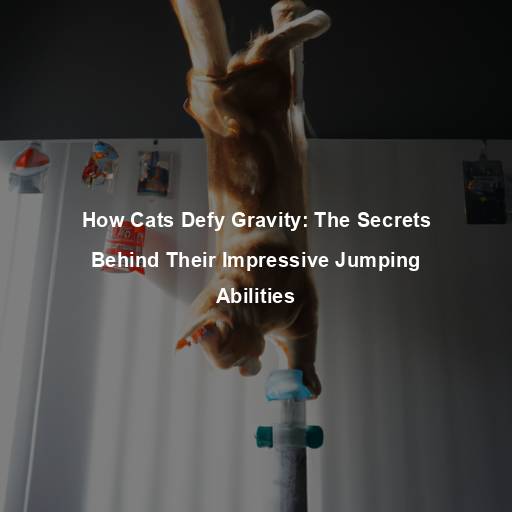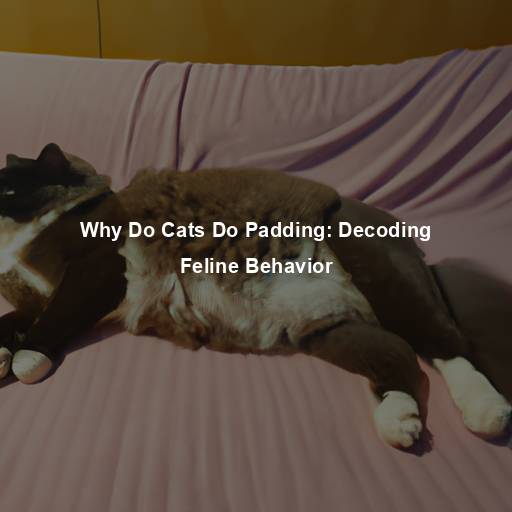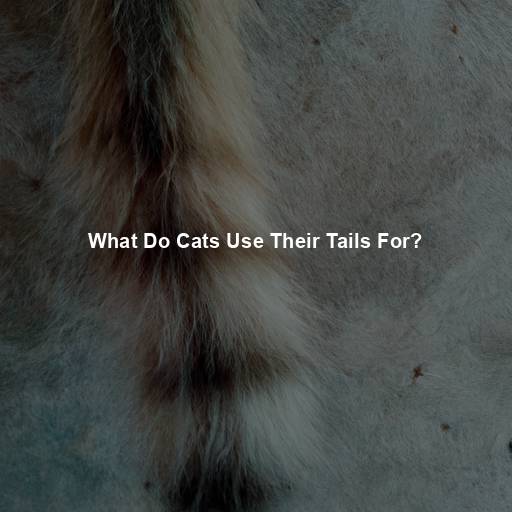Where Do Cats Get Their Balance From?
Last Updated on November 6, 2023 by Evan
Contents [hide]
- 1 The Intricate Balance of Feline Acrobatics
- 1.1 Anatomy of Balance: The Inner Ear
- 1.2 Tail as a Counterbalance: The Tails Tell
- 1.3 Paws: The Pinnacle of Precision
- 1.4 Flexibility and Muscular Agility
- 1.5 Instinctual Adaptations: Nature’s Gift
- 1.6 Evolutionary Origins: Honing the Balance
- 1.7 Training and Practice: Refining the Skills
- 1.8 The Astonishing Feline Balance: Awe-Inspiring Grace
- 1.9 Visual Tracking: A Cat’s Precision Tool
- 1.10 Muscle Control: The Fine Art of Balance
- 1.11 The Curious Case of the “Righting Reflex”
- 1.12 Training and Enrichment: Nurturing the Balance
- 1.13 Health and Balance: A Delicate Equilibrium
- 1.14 The Fascination of Feline Balance: A Never-Ending Exploration
- 1.15 Balance and Hunting: A Deadly Combination
- 1.16 The Role of Balance in Playtime
- 1.17 Balance in Everyday Activities
- 1.18 The Impact of Aging on Balance
- 1.19 Balance as a Reflection of Well-being
- 1.20 The Enduring Mystery of Feline Balance
- 1.21 In Awe of Feline Grace
- 2 FAQs – Where do cats get their balance from?
- 2.1 How do cats maintain such great balance?
- 2.2 How does a cat’s inner ear contribute to their balance?
- 2.3 What makes a cat’s body flexible and aids in its balance?
- 2.4 What is proprioception, and how does it contribute to a cat’s balance?
- 2.5 Are all cats born with a natural sense of balance?
- 2.6 Can a cat lose its balance?
The Intricate Balance of Feline Acrobatics
Delve into the enigmatic world of feline acrobatics as we unravel the mystique behind cats’ unparalleled balance and agility. From their astonishing ability to gracefully teeter on the edges of narrow ledges to their seemingly effortless leaps from one surface to another, these captivating creatures perplex us with their gravity-defying maneuvers. Join us on this enthralling journey as we uncover the secrets that lie beneath their exceptional sense of equilibrium and unlock the marvels of their innate balance.
Anatomy of Balance: The Inner Ear
When it comes to cats and their awe-inspiring balance, it all boils down to their remarkable inner ear design. It’s simply mind-blowing how the vestibular system tucked away in their ears works like a secret superhero, finely tuned to detect any shifts in head position and movement. Picture this: three semicircular canals, filled with fluid and adorned with microscopic cilia, those minuscule hair-like sensors that play a significant role in this marvel of feline equilibrium. As a cat gracefully sways, leaps, or pounces, the fluid within these canals does a tantalizing dance, setting the cilia in motion and triggering the brain to make sense of their position in the vast expanse of space.
Tail as a Counterbalance: The Tails Tell
Beyond their inner ear, cats also rely on their tails as a counterbalance to maintain equilibrium. A cat’s tail is an extension of its spine, composed of several flexible vertebrae. When a cat is leaping or balancing on a narrow surface, it instinctively extends its tail in the opposite direction to counterbalance its body weight. This unique adaptation enables cats to make precise movements and land gracefully even when performing daring acrobatic feats.
Paws: The Pinnacle of Precision
Another factor that contributes to a cat’s exceptional balance is its paws. Cats possess specialized paw pads that provide them with excellent traction and grip on various surfaces. These paw pads are equipped with numerous sensory receptors that allow cats to perceive even the slightest changes in texture or pressure. This heightened sensitivity enables them to make quick adjustments and maintain stability, even on slippery or uneven surfaces.
Flexibility and Muscular Agility
Cats have long been celebrated for their awe-inspiring ability to bend, twist, and maneuver their bodies in ways that seem almost otherworldly. It’s no secret that their skeletal framework, with a supple spine and resilient ligaments, grants them an unmatched level of pliancy. This remarkable adaptability ensures that cats can effortlessly distribute their weight, while their quick reflexes and nimble movements further enhance their poise and coordination. Truly, their mesmerizing flexibility leaves us in a state of perpetual wonder.
Instinctual Adaptations: Nature’s Gift
Cats possess an array of innate skills that simply defy gravity and leave us scratching our heads in awe. From the time they are mere kittens, these agile creatures engage in a symphony of playful antics that involve scaling heights, leaping through the air, and launching themselves in unexpected directions. By following their natural instincts, felines spectacularly fine-tune their bodies, forging an intricate dance of muscle, bone, and nerves that is nothing short of bewildering. And it is this enigmatic process that forms the bedrock for their astounding acrobatics as they grow into graceful, airborne marvels.
Evolutionary Origins: Honing the Balance
Cats’ incredible sense of balance can be traced back to their evolutionary origins. As natural hunters, cats needed to navigate diverse terrains and environments with precision and stealth. Over millions of years, their ancestors developed specialized adaptations that allowed them to move with grace and agility, ensuring their survival in the wild. The feline lineage that exists today is a testament to the successful evolution of these remarkable balance-enhancing traits.
Training and Practice: Refining the Skills
Cats are truly fascinating creatures, effortlessly showcasing their natural balance and grace. However, did you know that they can take these skills to even greater heights with a bit of training and practice? It turns out that many cat owners are finding innovative ways to challenge their feline friends by setting up obstacle courses or introducing interactive toys. By encouraging exploration and play, these activities not only keep our furry companions entertained but also enhance their already exceptional sense of balance, ensuring they remain the epitome of elegance throughout their lives.
The Astonishing Feline Balance: Awe-Inspiring Grace
At the heart of a feline’s remarkable balance lies a symphony of visual cues and sensory inputs. Their finely-tuned inner ear structure allows them to perceive even the slightest shift in gravitational forces, while their tails act as the perfect counterbalance, adding a touch of elegance to their every move. As if that weren’t enough, their specialized paw pads provide a sensory wonderland, offering a tactile tapestry that enhances their spatial awareness. It is through millions of years of evolution and the instinctual adaptations honed through their hunting prowess that cats have mastered the art of balance, leaving humans in perpetual awe of their graceful maneuvers.
While we have discussed the importance of the inner ear, tail, paws, flexibility, and instinctual adaptations in a cat’s balance, we cannot overlook the significant role that vision plays in their acrobatic prowess. Cats have exceptional visual acuity and depth perception, allowing them to accurately judge distances and make precise movements. Their eyes are positioned at the front of their heads, providing them with overlapping fields of vision, which enhances their ability to focus on objects and maintain balance while navigating their surroundings.
Visual Tracking: A Cat’s Precision Tool
There’s something captivating about cats, isn’t there? They possess this extraordinary talent called visual tracking, a skill that sets them apart from other animals. Picture this: a cat gracefully tracking a moving object with utmost precision. It’s like watching a mesmerizing dance, a blend of hunting and playfulness.
Muscle Control: The Fine Art of Balance
To maintain their balance, cats rely on intricate muscle control. As they leap, climb, or land, their muscles work in perfect harmony, adjusting their body position and distributing weight effectively. The coordination between their muscles and nervous system is a testament to their exceptional control and balance. This finely tuned muscle control allows cats to make precise and calculated movements, even in the most challenging and precarious situations.
The Curious Case of the “Righting Reflex”
Few things captivate us more than the sheer marvel of a cat’s balance. It’s inexplicable, really, how they possess such an uncanny knack for correcting their trajectory mid-fall. This innate reflex, aptly named the “righting reflex,” is a mesmerizing dance of agility and precision. As if guided by some hidden force, cats contort their bodies in an elaborate choreography of arching, twisting, and tucking, defying gravity with a seemingly effortless grace.
Training and Enrichment: Nurturing the Balance
Are you looking for ways to challenge and engage your feline friend? Just like humans, cats can also benefit from a little mental and physical workout. By incorporating interactive play sessions into their daily routine, you can provide them with the perfect opportunity to sharpen their claws and flex their balance skills. Introducing climbing structures and perches will not only give them a bird’s eye view of their kingdom but also help them navigate their surroundings with grace.
Health and Balance: A Delicate Equilibrium
Ensuring your feline companion’s wellbeing goes beyond kitty cuddles and tasty treats. Just like us, cats rely on their sense of balance to navigate their world with grace and agility. However, sometimes unexpected health issues arise, causing a whirlwind of confusion in their delicate equilibrium. From pesky ear infections to mysterious vestibular disorders and even peskier musculoskeletal problems, these sneaky culprits can throw your furball’s balance off-kilter.
The Fascination of Feline Balance: A Never-Ending Exploration
Embarking on a journey through the enigmatic realm of feline equilibrium reveals a captivating union of grace and mystique. Within the depths of their beings, cats harbor a mesmerizing array of adaptations that unfathomably contribute to their astonishing sense of balance. Whether adroitly traversing narrow precipices or scaling heights with effortless agility, these marvelous creatures epitomize the profound culmination of millions of years of evolution and the tenacious influence of their innate instincts. As we delve further into studying and embracing the marvels of the feline world, we are compelled to marvel at the unwavering connection between balance and confidence, perpetually reminding us of the boundless intricacies and bewildering allure of the animal kingdom.
A cat’s exceptional balance goes hand in hand with their innate confidence. It is this confidence that allows them to explore their surroundings with poise and grace, even in the face of potential challenges. Cats’ ability to maintain balance in various situations gives them the assurance to navigate their environment with ease and take on daring feats that may seem impossible to us.
Balance and Hunting: A Deadly Combination
Cats’ exceptional balance plays a vital role in their hunting prowess. Whether stalking their prey or pouncing with lightning speed, their ability to maintain balance allows them to execute precise movements, giving them the upper hand in capturing their target. Their keen sense of equilibrium allows them to remain focused and agile, ensuring a successful hunt. The combination of balance, agility, and stealth makes cats formidable predators in the animal kingdom.
The Role of Balance in Playtime
The art of balance transcends the realm of hunting and becomes a fundamental element of play for our feline friends. As our beloved cats engage in their adventurous play, they partake in an array of interactive behaviors, such as chasing toys or indulging in daring mock battles with their fellow felines. Amidst these lively escapades, their remarkable sense of balance takes center stage, allowing them to effortlessly execute stunning turns, leaps, and twists that inject an undeniable thrill into their play sessions. Not only does play bring joy to our furry companions, but it also serves as a means for them to refine their delicate equilibrium and coordination skills, ensuring they remain mentally stimulated and physically poised.
Balance in Everyday Activities
The art of equilibrium goes far beyond mere hunting and play for our feline companions. It is the invisible thread that weaves through every facet of their lives, guiding them through a perplexing world with unmatched grace. Whether gracefully perched on a windowsill or fearlessly scaling towering heights, their balance is the key to their safety and the foundation of their innate curiosity. With an awe-inspiring finesse, cats effortlessly navigate the most treacherous terrains, leaving us mere humans in a continuous state of amazement.
The Impact of Aging on Balance
As cats age, their balance may be affected. Older cats may experience changes in their joint mobility, muscle strength, or sensory perception, which can impact their balance. It is important for cat owners to provide a safe and supportive environment for their senior feline companions, ensuring that they have easy access to their favorite perching spots, litter boxes, and food bowls. Regular veterinary check-ups can help address any age-related balance issues and provide appropriate care and interventions.
Balance as a Reflection of Well-being
A cat’s balance is not only a physical attribute but also a reflection of their overall well-being. Cats that are stressed, anxious, or unwell may experience changes in their balance or coordination. It is crucial for cat owners to be attentive to any signs of imbalance or unusual behavior, as it may indicate an underlying health issue or emotional stress. Providing a nurturing and enriched environment, along with regular veterinary care, can help support a cat’s balance and contribute to their overall happiness and contentment.
The Enduring Mystery of Feline Balance
The enigma surrounding a cat’s unparalleled equilibrium is an ever-unfolding tapestry of fascination and perplexity. While we have gleaned valuable insights into the delicate interplay of their inner ear, acute sight, precise muscle control, and innate adaptations, there exist tantalizing mysteries yet to be unraveled. As we plunge deeper into the realm of feline balance, we unearth the intricate intricacies that bestow upon these magnificent beings an undeniable grace and allure, captivating both researchers and admirers alike.
In Awe of Feline Grace
When it comes to balance, cats are true wonders of nature. Their innate ability to maintain equilibrium is nothing short of astonishing, as every single aspect of their anatomy and behavior seems to be perfectly calibrated for this purpose. From their intricate inner ear mechanisms to their delicately poised paws and finely-tuned muscles, every detail plays a role in their exceptional balance. Watching them gracefully navigate their surroundings, effortlessly leaping and landing with unparalleled precision, we are left in a state of sheer amazement.
FAQs – Where do cats get their balance from?
How do cats maintain such great balance?
When it comes to awe-inspiring acrobatics, cats reign supreme with their mind-boggling balance skills. They gracefully maneuver across tightropes-like ledges, conquer towering trees with feline finesse, and perform gravity-defying leaps that leave us utterly perplexed. It’s their intricate inner ear, the lithe flexibility of their bodies, and an uncanny sense of proprioception that propel these sleek creatures into the realm of sheer balance brilliance. Step into their world of extraordinary equilibrium, where the laws of physics seem to bend to their feline will.
How does a cat’s inner ear contribute to their balance?
The inner ear of a cat plays a vital role in maintaining their balance. It contains semicircular canals that are filled with fluid and lined with specialized sensory cells. These cells detect movements of the fluid as the cat moves, providing crucial information about the position and orientation of its head and body. This constant feedback enables cats to adjust their movements accordingly and maintain their balance even in challenging situations.
What makes a cat’s body flexible and aids in its balance?
The inherent flexibility of a cat’s body significantly contributes to its exceptional balance. Cats possess a highly flexible spine consisting of numerous vertebrae, which allows them to twist, turn, and maintain stability during intricate movements. Additionally, their powerful leg muscles and retractable claws serve as essential tools for maintaining balance while climbing, ensuring a strong grip on various surfaces.
What is proprioception, and how does it contribute to a cat’s balance?
Have you ever marveled at a cat’s extraordinary agility and deftness? It is the remarkable sense of proprioception that grants felines their unmatched prowess. This innate ability allows them to effortlessly gauge the position, movement, and orientation of each body part, granting them an uncanny awareness of their surroundings. From impossible leaps to graceful landings, cats possess a bewildering control over their bodies, a testament to their unparalleled balance and precision.
Are all cats born with a natural sense of balance?
Yes, all cats, regardless of breed or size, are born with an innate sense of balance. From an early age, kittens learn to control and coordinate their movements, honing their balance skills through exploration and play. As they grow, their balance becomes more refined, allowing them to perform extraordinary feats with ease.
Can a cat lose its balance?
While cats are known for their exceptional balance, certain factors can temporarily impact their equilibrium. Illnesses, injuries, or conditions affecting their inner ears, muscles, or joints can disrupt their sense of balance. Additionally, if a cat is startled, pushed, or placed in an unstable environment, it might momentarily lose its balance. However, in most cases, cats quickly regain their equilibrium and resume their impressive balancing abilities.






